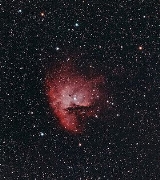
NGC 281
Encyclopedia
NGC 281 is an H II region
in the constellation of Cassiopeia and part of the Perseus Spiral Arm. It includes the open cluster
IC 1590, the multiple star HD 5005, and several Bok globule
s. Colloquially, NGC 281 is also known as the Pacman Nebula for its resemblance to the video game character
.
The nebula was discovered in August 1883 by E. E. Barnard, who described it as "a large faint nebula, very diffuse." The multiple star HD 5005, also called , was discovered by S. W. Burnham. It consists of an 8th-magnitude primary with four companions at distances between 1.4 and 15.7 seconds of arc. There has been no appreciable change in this quintuple system since the first measurements were made in 1875.
, was discovered by S. W. Burnham. It consists of an 8th-magnitude primary with four companions at distances between 1.4 and 15.7 seconds of arc. There has been no appreciable change in this quintuple system since the first measurements were made in 1875.
The nebula is visible in amateur telescopes from dark sky locations.
In his book Deep Sky Wonders, Walter Scott Houston
describes the appearance of the nebula in small telescopes:
H II region
An H II region is a large, low-density cloud of partially ionized gas in which star formation has recently taken place. The short-lived, blue stars forged in these regions emit copious amounts of ultraviolet light, ionizing the surrounding gas...
in the constellation of Cassiopeia and part of the Perseus Spiral Arm. It includes the open cluster
Open cluster
An open cluster is a group of up to a few thousand stars that were formed from the same giant molecular cloud and have roughly the same age. More than 1,100 open clusters have been discovered within the Milky Way Galaxy, and many more are thought to exist...
IC 1590, the multiple star HD 5005, and several Bok globule
Bok globule
Bok globules are dark clouds of dense cosmic dust and gas in which star formation sometimes takes place. Bok globules are found within H II regions, and typically have a mass of about 2 to 50 solar masses contained within a region about a light year or so across...
s. Colloquially, NGC 281 is also known as the Pacman Nebula for its resemblance to the video game character
Pac-Man
is an arcade game developed by Namco and licensed for distribution in the United States by Midway, first released in Japan on May 22, 1980. Immensely popular from its original release to the present day, Pac-Man is considered one of the classics of the medium, virtually synonymous with video games,...
.
The nebula was discovered in August 1883 by E. E. Barnard, who described it as "a large faint nebula, very diffuse." The multiple star HD 5005, also called
 , was discovered by S. W. Burnham. It consists of an 8th-magnitude primary with four companions at distances between 1.4 and 15.7 seconds of arc. There has been no appreciable change in this quintuple system since the first measurements were made in 1875.
, was discovered by S. W. Burnham. It consists of an 8th-magnitude primary with four companions at distances between 1.4 and 15.7 seconds of arc. There has been no appreciable change in this quintuple system since the first measurements were made in 1875.The nebula is visible in amateur telescopes from dark sky locations.
In his book Deep Sky Wonders, Walter Scott Houston
Walter Scott Houston
Walter Scott Houston was an American popularizer of amateur astronomy. He wrote the "Deep-Sky Wonders" column in Sky and Telescope magazine from 1946 to 1993.-Biography:...
describes the appearance of the nebula in small telescopes:
There was a faint glow in the immediate vicinity of the multiple star, with an occasional impression of a much larger nebulosity...Its surface brightness was much less than that of M33 in Triangulum or NGC 205, the distant companion of the Andromeda galaxy.
External links
- NGC 281 Astronomy picture of the Day (August 23, 2005) at NASA
- NGC 281 at ESA/Hubble

